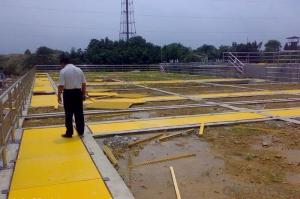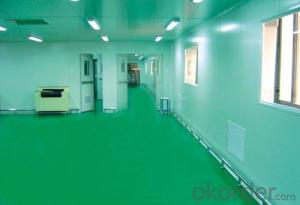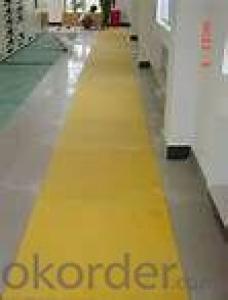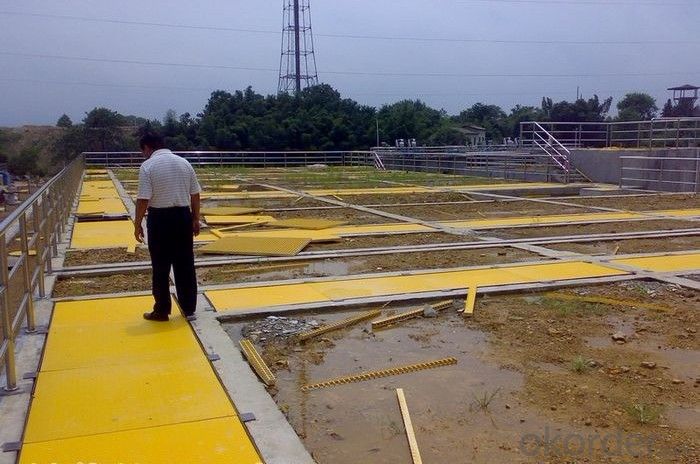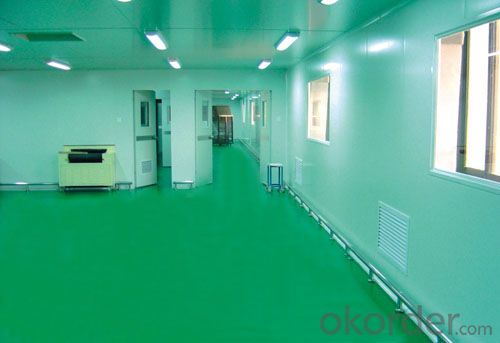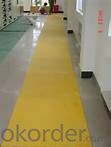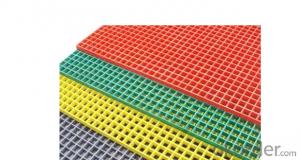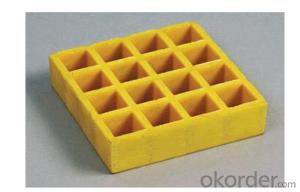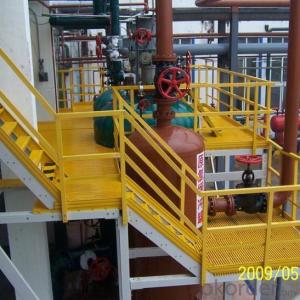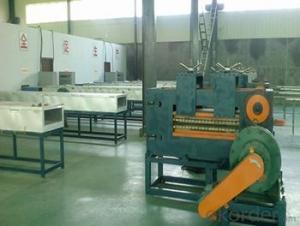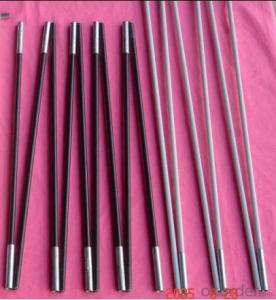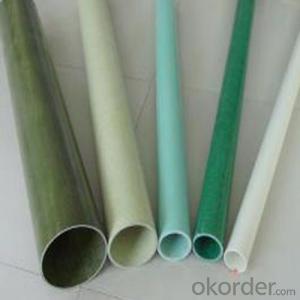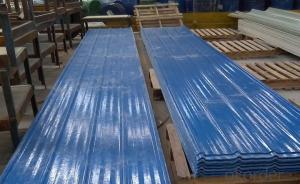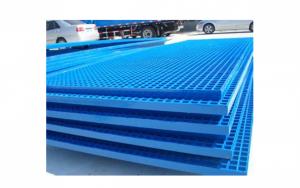FRP Pultrusion Profiles - Solid FRP Flooring Panel
- Loading Port:
- China Main Port
- Payment Terms:
- TT or LC
- Min Order Qty:
- -
- Supply Capability:
- -
OKorder Service Pledge
OKorder Financial Service
You Might Also Like
1.Brief Introduction
GRPGratings are produced by wet moulding and hot curing in a heated mould. Thereinforcement consists of continuous fibreglass rovings in alternating layers.So the loads are distributed evenly in all directions.
Design
Regularly Moulded GRP Gratings have a polyester resinmatrix. Glass content is approximately 35%. Standard colours are green, yellowor grey, other colours are available according to RAL.
2.Characteristics
GRPGratings are produced by wet moulding and hot curing in a heated mould. Thereinforcement consists of continuous fibreglass rovings in alternating layers.So the loads are distributed evenly in all directions.
Design
Regularly Moulded GRP Gratings have a polyester resinmatrix. Glass content is approximately 35%. Standard colours are green, yellowor grey, other colours are available according to RAL.
1)corrosion/slip resistant
2) fire/impact retardant
3) high strength-to-weight ratio
4) easy to install and to maintain
3.Product Specifications
Item no. | Height(mm) | Mesh Size | Standard Panel Sizes | Bar Thickness | Open Area | Weight |
1 | 13 | 50.8×50.8 | 3660×1220 | 6.4 / 5.4 | 76% | 5.5 |
2 | 15 | 25.4×25.4 / 50.8×50.8 | 3660×1220 | 6.2 / 5 | 57% | 7.2 |
3 | 15 | 38.1×38.1 | 3660×1225 | 6.3 / 5.2 | 69% | 6.5 |
4 | 15 | 20×20 / 40×40 | 4047×1247 | 6.35 / 5.3 | 47% | 11.5 |
5 | 20 | 38.1×38.1 | 3665×1225 | 6.3 / 5 | 69% | 9.3 |
6 | 20 | 12.8×12.8×12.8 / 38.5×38.5 | 3434×970 | 7.2 / 6.4 | 27% | 18.5 |
7 | 25 | 38.1×38.1 | 3665×1225 | 6.35 / 5 | 69% | 12.3 |
8 | 25 | 40×40 | 4047×1007 | 6.35 / 5 | 70% | 12.2 |
9 | 25 | 19×19 / 38×38 | 4005×1220 | 6.4 / 5 | 44% | 15.5 |
10 | 25 | 25×100(Bearing bars to run width direction) | 3007×1009 | 9.4 / 8(length) | 67% | 13.8 |
11 | 25 | 25.4×101.6(Bearing bars to run width direction) | 3660×1220 | 7 / 5 | 67% | 13.0 |
12 | 25 | 101.6×25.4(Bearing bars to run length direction) | 3665×1225 | 7 / 5 | 67% | 13.1 |
13 | 30 | 38.1×38.1 | 4008×1525 | 6.6 / 5 | 68% | 14.6 |
14 | 30 | 40×40 | 4047×1007 | 6.6 / 5 | 69% | 14.2 |
15 | 30 | 20×20 / 40×40 | 4047×1247 | 7 / 5 | 42% | 18.1 |
16 | 30 | 12.7×12.7×12.7 / 38×38 | 4040×1220 | 7 / 5 | 30% | 23.5 |
17 | 30 | 26×26 / 52×52 | 4011×1150 | 6.5/5 | 56% | 13.6 |
18 | 38 | 38.1×38.1 | 3969×1525 | 7 / 5 | 66% | 19.2 |
19 | 38 | 40×40 | 4047×1007 | 7 / 5 | 67% | 18.8 |
20 | 38 | 152.4×25.4(Bearing bars to run length direction) | 3665×1226 | 7 / 5(length) | 68% | 20.4 |
21 | 38 | 101.6×38.1(Bearing bars to run length direction) | 3660×1220 | 7 / 5 | 76% | 14.5 |
22 | 38 | 19×19 / 38.1×38.1 | 4045×1220 | 7 / 5 | 40% | 23.5 |
23 | 38 | 20×20 / 40×40 | 4047×1247 | 7 / 5 | 42% | 22 |
24 | 40 | 40×40 | 4047×1247 | 7 / 5 | 67% | 20.0 |
25 | 40 | 220×60 | 2207×1507 | 7 / 5 | 85% | 9.5 |
26 | 40 | 20×20 / 40×40 | 4047×1207 | 7 / 5 | 42% | 23.7 |
27 | 50 | 50.7×50.7 | 3660×1225 | 8.3 / 5 | 69% | 21.5 |
28 | 50 | 50.7×50.7 | 3660×1225 | 8.8 / 5 | 68% | 23.5 |
29 | 50 | 25.35×25.35 / 50.7×50.7 | 3660×1220 | 8 / 6 | 47% | 26.0 |
30 | 50 | 152.4×38.1(Bearing bars to run length direction) | 3660×1220 | 9 / 7 | 72% | 20.8 |
31 | 50 | 38.1×38.1 | 3665×1225 | 11.5 / 9 | 48% | 40.5 |
32 | 63 | 38.1×38.1 | 3660×1220 | 12 / 9 | 47% | 52 |
33 | 63 | 38.1×38.1 | 3670×1230 | 12 / 9 | 46% |
4.FAQ
Excellent Properties
1. Corrosion and chemicalresistant
Corrosionis a major problem for metal or wooden grating, stair treads and other productsin many different industries such as chemical plants, food and beveragefactories, water and wastewater facilities, power facilities. MINCOM®grating isparticularly designed to provide safe, long-lasting, economical and worry-freesolutions in environments where chemicals and other corrosive materials attackand destroy metal or wood. According to different environmental requirements,such resins as orthophthalic polyester, is ophthalmic polyester, vinylester orphenolic are chosen as matrix material.
2.High strength-to-weight ratio
gratingmanufactured as a composite of continuous fiberglass strands and high qualityresin is integrally constructed for strength, but it is less than one-half theweight of steel grating allowing easy removal for access below floor level andinstallation with no heavy equipment and less manpower. gratings meet specified load requirements for steel and are more impactresistant than metal.
3. Fire retardant
gratinghas flame spread rating of 25 or less depending on different resin systems astested in term of ASTM E-84. Test Report can be offered upon request. Specialfire retardant requirements can also be met by adding extra additives.
4. Ergonomic
Employeesare experiencing fatigue after standing on solid concrete or heavynon-adjustable galvanized steel platforms all day, gratings are the bestsolutions to ease the strain on the backs, feet and legs of workers increasingworkers’ comfort and productivity due to its natural slight resiliency thatmakes them comfortable to stand on for a long period.
5. Slip-resistant
moldedgrating has a concave top surface for slip resistance after it is extractedfrom the mold. Should a grit surface be specified, the grit would be eitherbonded to the top of the completed grating as a secondary operation or embeddedto the top of grating before heating, both providing superior slip resistance.Diamond cover top or gritted cover top are also available upon request.
6. Anti-aging
Morethan 20 years of Life is guaranteed for MINCOM®FRP gratings.
7. Easymaintenance
Installit and forget about it. MINCOM®grating is easy to clean, its open meshespermitting debris to fall through grating panel and preventing hazardousbuildup on walking surface. MINCOM®grating is free from re-painting year afteryear not only for the inherent corrosion resistance but also for the molded-incolor and ultraviolet resistance character.
8.Safety
NON-CONDUCTIVE property makes MINCOM®grating ideallysuitable in electrically hazardous locations acting as an insulator.
NON-MAGNETIC property allows MINCOM® grating to be used in sensitiveinstallations where the inherent magnetic properties of metal grating willprove dangerous.
9. Comprehensive economical efficiency
Thecost of FRP grating is about 10% to 30% higher than that of steel grating, Butthe installation cost is about 60-80%lower! And steel grating have to be maintained everyyear. FRP grating is free of maintainence! The comprehensiveeconomical efficiency is much higher than that of steel grating.
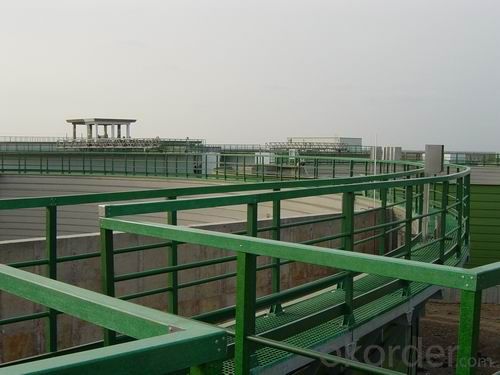
- Q: Are FRP pultrusion profiles resistant to oil and grease?
- Yes, FRP pultrusion profiles are highly resistant to oil and grease due to the inherent properties of the fiberglass reinforcement used in their construction. The composite material offers excellent chemical resistance, making it suitable for applications where exposure to oil and grease is expected.
- Q: Can FRP pultrusion profiles be used in the construction of offshore platforms?
- Yes, FRP (Fiber Reinforced Polymer) pultrusion profiles can be used in the construction of offshore platforms. FRP pultrusion profiles have several advantageous properties that make them suitable for offshore applications. Firstly, FRP pultrusion profiles are lightweight yet strong, which is crucial for offshore platforms that need to withstand harsh environmental conditions such as strong winds, waves, and corrosive saltwater. The high strength-to-weight ratio of FRP makes it an ideal choice for reducing overall weight while maintaining structural integrity. Secondly, FRP is highly resistant to corrosion, unlike traditional construction materials such as steel. This is particularly important in the offshore environment, where saltwater exposure can lead to rapid corrosion of metal structures. FRP pultrusion profiles do not rust or corrode, resulting in longer service life and reduced maintenance costs. Furthermore, FRP pultrusion profiles can be designed and manufactured to have excellent fire resistance properties. This is crucial for offshore platforms, as fire incidents can have catastrophic consequences. FRP materials can be engineered to meet specific fire safety standards, providing an added layer of protection. Additionally, FRP pultrusion profiles offer design flexibility, as they can be easily customized to meet specific project requirements. This allows for the creation of complex shapes and sizes, enabling efficient construction and installation of offshore platforms. Overall, the lightweight, corrosion-resistant, fire-resistant, and customizable nature of FRP pultrusion profiles make them a suitable choice for the construction of offshore platforms. They offer numerous advantages over traditional materials, contributing to improved safety, durability, and cost-effectiveness in offshore construction projects.
- Q: Are FRP pultrusion profiles resistant to chemicals used in pharmaceutical manufacturing?
- Yes, FRP (Fiber Reinforced Plastic) pultrusion profiles are highly resistant to chemicals used in pharmaceutical manufacturing. FRP profiles are made by impregnating fibers with a resin matrix, typically polyester or vinyl ester, which provides excellent chemical resistance. These profiles are designed to withstand exposure to a wide range of chemicals including acids, alkalis, solvents, and various cleaning agents commonly used in pharmaceutical manufacturing processes. The combination of the fiber reinforcement and the chemical-resistant resin matrix makes FRP pultrusion profiles an ideal choice for applications where exposure to aggressive chemicals is a concern. Unlike traditional materials like steel or wood, FRP profiles do not corrode or react chemically with the substances they come into contact with. Furthermore, FRP pultrusion profiles offer several other advantages for pharmaceutical manufacturing applications. They have exceptional strength-to-weight ratio, are non-conductive, and have high mechanical resistance. Additionally, FRP is a non-porous material, preventing the absorption or release of chemicals, which is crucial for maintaining strict hygiene and avoiding contamination in pharmaceutical processes. Overall, FRP pultrusion profiles are a reliable and durable choice for pharmaceutical manufacturing environments, providing excellent resistance to the chemicals commonly used in these processes.
- Q: The manufacturing process of FRP products?
- Each technique has its own characteristics. Production enterprises determine the process method in the selection, according to the basic situation of the enterprise and the production of products, such as mass production and product quality requirements, as well as the technical basis for enterprise capital and production factors such as comprehensive consideration.
- Q: Can not use glass steel support column, the main support for the door
- The epoxy pultruded glass steel section is of high strength and can meet your requirement. You can choose the required section according to your requirement
- Q: How do FRP pultrusion profiles compare to steel or aluminum profiles?
- FRP (Fiber Reinforced Polymer) pultrusion profiles offer several advantages over steel or aluminum profiles. Firstly, FRP profiles are extremely lightweight, making them easier to handle and install. This is particularly beneficial in industries where weight reduction is crucial, such as aerospace or automotive applications. Another significant advantage of FRP pultrusion profiles is their exceptional corrosion resistance. Unlike steel or aluminum, FRP does not rust or corrode when exposed to moisture, chemicals, or harsh environmental conditions. This property makes FRP profiles ideal for applications in marine environments or chemical processing plants, where traditional materials would quickly deteriorate. In terms of strength, FRP pultrusion profiles can match or even surpass steel or aluminum profiles. The unique combination of reinforcing fibers and polymer resin in FRP provides excellent tensile and flexural strength. Additionally, FRP profiles have a high stiffness-to-weight ratio, meaning they can withstand heavy loads while remaining lightweight. Furthermore, FRP pultrusion profiles offer excellent electrical insulation properties. Unlike metal profiles, FRP does not conduct electricity, making it a safe choice for electrical applications where insulation is crucial. While steel or aluminum profiles may have their own advantages in certain applications, FRP pultrusion profiles often provide a more cost-effective solution due to their long lifespan and low maintenance requirements. FRP profiles are not susceptible to rust, corrosion, or degradation, minimizing the need for frequent repairs or replacements. Overall, FRP pultrusion profiles offer a compelling alternative to steel or aluminum profiles, providing lightweight, corrosion-resistant, strong, and electrically insulating solutions for various industries and applications.
- Q: What are pultrusion materials used for?
- Plastic pultrusion materials are used for drawing and blowing tubes
- Q: Can FRP pultrusion profiles be used in the aerospace industry?
- FRP pultrusion profiles are suitable for use in the aerospace industry. They possess several advantages that make them ideal for aerospace applications. Firstly, their high strength-to-weight ratios are crucial in the aerospace industry, where weight reduction is a top priority. This lightweight quality contributes to fuel efficiency and increased payload capacity. Secondly, FRP profiles have excellent corrosion resistance, making them perfect for aerospace applications that involve exposure to harsh environments like high altitude, extreme temperatures, and moisture. This resistance ensures the durability and longevity of the components, reducing maintenance and replacement costs. Additionally, FRP materials can be customized to meet specific design requirements, allowing engineers to easily create complex shapes and structures. This flexibility in design leads to enhanced performance and functionality in aerospace applications. Moreover, FRP pultrusion profiles exhibit exceptional fatigue resistance, enabling them to withstand the cyclic loading and stress cycles commonly encountered in aerospace operations. This characteristic ensures the reliability and safety of the components, which is paramount in the aerospace industry. Furthermore, FRP materials offer electrical insulation properties, which can be advantageous in aerospace applications where controlling or minimizing electrical conductivity is necessary. This insulation capability contributes to the overall safety and functionality of the components. In conclusion, FRP pultrusion profiles are a viable and attractive choice for various aerospace applications, including aircraft structures, interior components, radomes, and others. Their high strength-to-weight ratios, corrosion resistance, flexibility in design, fatigue resistance, and electrical insulation properties make them a suitable option for the aerospace industry.
- Q: How do FRP pultrusion profiles handle torsion loads?
- FRP pultrusion profiles are designed to handle torsion loads effectively due to their inherent properties. The continuous fibers in the profile provide excellent resistance to torsional forces, ensuring high strength and stability. The pultrusion manufacturing process also allows for precise control over the fiber orientation, resulting in profiles that can efficiently handle torsion loads without compromising their structural integrity.
- Q: Can FRP pultrusion profiles be used in electrical insulation applications?
- Yes, FRP (Fiber Reinforced Polymer) pultrusion profiles can be used in electrical insulation applications. FRP profiles offer excellent electrical insulation properties, making them suitable for a wide range of electrical applications. The high dielectric strength of FRP materials ensures that electrical currents are effectively contained within the desired pathways, preventing leakage and electrical hazards. Additionally, FRP profiles possess low electrical conductivity, reducing the risk of electrical shorts and improving overall safety in electrical insulation applications. The non-magnetic nature of FRP materials is also advantageous, as it eliminates the possibility of electromagnetic interference (EMI) in sensitive electrical systems. Furthermore, FRP pultrusion profiles are lightweight, corrosion-resistant, and have a long service life, making them a cost-effective and durable solution for electrical insulation applications.
Send your message to us
FRP Pultrusion Profiles - Solid FRP Flooring Panel
- Loading Port:
- China Main Port
- Payment Terms:
- TT or LC
- Min Order Qty:
- -
- Supply Capability:
- -
OKorder Service Pledge
OKorder Financial Service
Similar products
Hot products
Hot Searches
Related keywords
